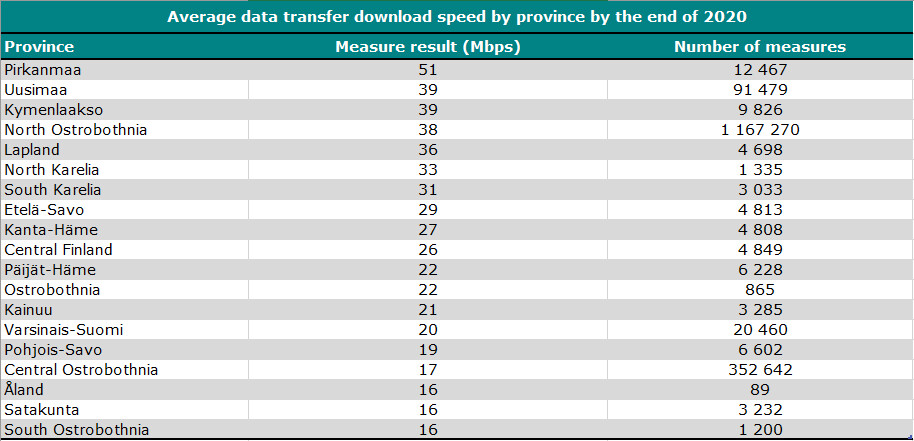Mobile network performance measurements
These statistics include the results of mobile network speed measurements carried out in 2015–2020 by users of the Mobiilimittari application provided by VTT Technical Research Centre of Finland Ltd. The statistics cover the results of speed tests where the download speed was successfully measured, the mobile network technology was identified (2G, 3G, 4G or 5G) and location data was successfully received. The statistics do not include speed measurements that VTT has conducted using its own fixed measurement points. These statistics are currently not being updated.
Mobile network subscription contracts include a reference to the estimated maximum download speed of data transfer. Usually, these maximum rates are 50 Mbps, 100 Mbps or 150 Mbps. The maximum rate means the speed at which users can download data in an ideal situation. In other words, the transmission speed will not, as a rule, exceed the maximum rate.
In reality, however, the rates used in the marketing of mobile subscriptions are hardly ever met, and many operators give a range within which the speed may vary. In addition to the subscription, download speeds depend on the device used, obstacles in the natural environment, buildings and other constructions, and the number of users using the same mobile network in the base station coverage area.
The data transfer speed of a phone or other mobile device can be measured with various speed tests. The Finnish Transport and Communications Agency Traficom acquired data from the VTT Mobiilimittari application for a period of five years. Key findings about the data are presented on this page.
The first figure illustrates the average download speeds and the minimum and maximum rates achieved in speed measurements in 2015–2020. No clear trend of increasing data transfer speeds can be observed in the data, even though the mobile coverage data gathered by Traficom suggests that faster connections of 100 Mbps have become available to an increasing share of the population over the years.
The second figure shows the average download speed by each hour of the day in 2015–2020. There is some variation year on year, but the common trend for all years covered is that the average download speed is at its highest from 1 am to 8 am. During these hours, there are fewer users in mobile networks and more capacity available for individual users. This translates into higher download speeds.
During the day, average speeds steadily decrease from the morning rates. Speed rates are at their lowest from approximately 8 pm to 10 pm. In the evening, many people use the network for example to watch videos, which may occasionally lead to network congestion and slow connections.

The table summarises the volumes of speed tests performed and the average download speed by region by the end of 2020. Test volumes for North and Central Ostrobothnia are significantly higher than in other regions. This is mainly due to the measurements carried out at VTT’s Oulu unit.
Definitions
Download speed means the rate at which data is transferred from the internet to the user’s device.
Upload speed means the rate at which data is transferred from the user’s device to the internet.